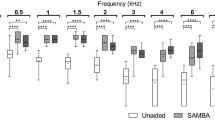Abstract
The RONDO is a single-unit cochlear implant audio processor, which omits the need for a behind-the-ear (BTE) audio processor. The primary aim was to compare speech perception results in quiet and in noise with the RONDO and the OPUS 2, a BTE audio processor. Secondary aims were to determine subjects’ self-assessed levels of sound quality and gather subjective feedback on RONDO use. All speech perception tests were performed with the RONDO and the OPUS 2 behind-the-ear audio processor at 3 test intervals. Subjects were required to use the RONDO between test intervals. Subjects were tested at upgrade from the OPUS 2 to the RONDO and at 1 and 6 months after upgrade. Speech perception was determined using the Freiburg Monosyllables in quiet test and the Oldenburg Sentence Test (OLSA) in noise. Subjective perception was determined using the Hearing Implant Sound Quality Index (HISQUI19), and a RONDO device-specific questionnaire. 50 subjects participated in the study. Neither speech perception scores nor self-perceived sound quality scores were significantly different at any interval between the RONDO and the OPUS 2. Subjects reported high levels of satisfaction with the RONDO. The RONDO provides comparable speech perception to the OPUS 2 while providing users with high levels of satisfaction and comfort without increasing health risk. The RONDO is a suitable and safe alternative to traditional BTE audio processors.

Similar content being viewed by others
References
Lorenzi C, Gilbert G, Carn H, Garnier S, Moore BC (2006) Speech perception problems of the hearing impaired reflect inability to use temporal fine structure. Proc Natl Acad Sci USA 103:18866–18869
Hopkins K, Moore BC, Stone MA (2008) Effects of moderate cochlear hearing loss on the ability to benefit from temporal fine structure information in speech. J Acoust Soc Am 123:1140–1153. doi:10.1121/1.2824018
Wimmer W, Caversaccio M, Kompis M (2015) Speech intelligibility in noise with a single-unit cochlear implant audio processor. Otol Neurotol 36:1197–1202. doi:10.1097/MAO.0000000000000775
Mertens G, Kleine Punte A, De Bodt M, van de Heyning P (2015) Sound quality in adult cochlear implant recipients using the HISQUI19. Acta Otolaryngol 135:1138–1145. doi:10.3109/00016489.2015.1066934
Mertens G, Hofkens A, Kleine Punte AK, De Bodt M, van de Heyning P (2015) Hearing performance in single-sided deaf cochlear implant users after upgrade to a single-unit speech processor. Otol Neurotol 36:51–60. doi:10.1097/MAO.0000000000000653
Távora-Vieira D, Miller S (2015) The benefits of using RONDO and an in-the-ear hearing aid in patients using a combined electric-acoustic system. Adv Oto-Rhino-Laryng, vol 2015, 4 pages. doi:10.1155/2015/941230 (Article ID 941230)
Author information
Authors and Affiliations
Corresponding author
Ethics declarations
Conflict of interest
The authors declare no conflict of interest.
Additional information
This research was conducted at the: Comprehensive Hearing Center, Klinik und Poliklinik für Hals-, Nasen- und Ohrenkrankheiten, plastische und ästhetische Operationen, Josef-Schneider-Str. 11, 97080 Würzburg, Germany.
Rights and permissions
About this article
Cite this article
Dazert, S., Thomas, J.P., Büchner, A. et al. Off the ear with no loss in speech understanding: comparing the RONDO and the OPUS 2 cochlear implant audio processors. Eur Arch Otorhinolaryngol 274, 1391–1395 (2017). https://doi.org/10.1007/s00405-016-4400-z
Received:
Accepted:
Published:
Issue Date:
DOI: https://doi.org/10.1007/s00405-016-4400-z




